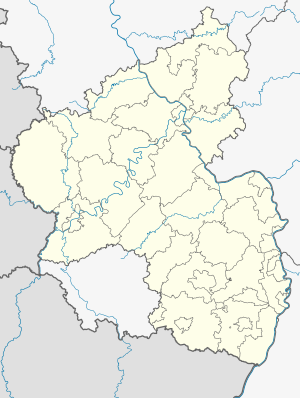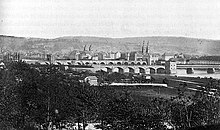Moselle railway bridge
Coordinates: 50 ° 21 ′ 50 ″ N , 7 ° 35 ′ 26 ″ E
| Moselle railway bridge Koblenz | ||
|---|---|---|
| use | railroad | |
| Convicted | left Rhine route | |
| Subjugated | Moselle | |
| place | Koblenz | |
| Entertained by | Deutsche Bahn | |
| construction | Girder bridge | |
| overall length | 270 m | |
| Clear height | 3.02-5.16 | |
| start of building | 1857 | |
| completion | 1858 | |
| opening | November 11, 1858 | |
| location | ||
|
|
||
| Map of the railway facilities in the greater Koblenz area | ||
The Moselle railway bridge in Koblenz crosses the Moselle between the old town and Lützel districts . The bridge at Moselle kilometer 1.25 crosses the left Rhine route from Cologne to Mainz and was built in 1858 for the first railway line to Koblenz. Today's bridge construction dates back to 1975 after it was destroyed in the war. South of the bridge, the Moselle route joins the Rhine route.
history
Established 1857–1858
After a railway connection between Cologne and Bonn had already been completed in 1844 and an extension to Rolandseck had existed since 1856 , the railway line has now been expanded to Koblenz. The foundation stone of the Moselle railway bridge was laid on November 11, 1857 in the presence of the future Empress Augusta . The first train of the Rheinische Eisenbahn-Gesellschaft drove on November 11, 1858 over the completed Moselle railway bridge into the provisionally built Rheinbahnhof in Eisenbahnstrasse (today Fischelstrasse). The route was extended from Koblenz to Bingerbrück in 1859 . The temporary station was replaced by a solid structure.
With the construction of the Moselle Railway Bridge and the Rhine Railway, the Prussian city fortifications of Koblenz were broken through for the first time . The bridge, which was built according to plans by the railway engineer Emil Hermann Hartwich , took into account the military requirements, as can be seen from the remains of the bridge towers. The bridge spans the Moselle over a length of 270 meters. The originally flat iron lattice bridge had four river openings on the inner city side and six stone arches on the Lützel side. In the middle at the transition between the lattice structure and the stone bridge there were two fortress-like square towers. The inner city side was provided with two strong head towers.
The Rheinbahnhof built on the south side of the Moselle was abandoned in 1902 in favor of the newly built Koblenz Hauptbahnhof . It was more conveniently located for the railroad, but was further away from the city center. The Moselle railway bridge was modified and reinforced in 1908, 1911, 1918, 1927 and 1931. The iron construction was completely renewed in 1918 and improved the rail route between Koblenz main train station and Koblenz-Lützel train station . The bridge was now doubled and instead of the lattice construction, steel arches spanned the inner-city side of the Moselle.
War destruction and new construction
At the end of the Second World War, the Moselle railway bridge, like all Koblenz bridges, was blown up by the retreating units of the Wehrmacht in March 1945 , but a short time later it was temporarily repaired by American troops using a makeshift bridge. Then the bridge was restored in the old construction. In the 1950s, after completion of the Koblenz barrage and as part of the Moselle canalization, a shipping canal was built in the area of the stone arch bridge on the Lützel side.
A complete renovation took place in 1974–1975. The arch construction from the inner city side to the middle of the river was replaced by a modern box construction , the stone arch bridge up to the Lützel side was retained. The bridge towers belonging to the Prussian fortress Koblenz were demolished down to the level of the track and each covered with a concrete slab, so that only their basement remains.
See also
literature
- Energieversorgung Mittelrhein GmbH (ed.): History of the city of Koblenz. Overall editing: Ingrid Bátori in conjunction with Dieter Kerber and Hans Josef Schmidt. Theiss, Stuttgart 1992-1993;
- Volume 1: From the beginning to the end of the electoral era. 1992, ISBN 3-8062-0876-X ;
- Volume 2: From the French city to the present. 1993, ISBN 3-8062-1036-5 .
- City of Koblenz (Ed.): Koblenz City of Bridges , documentation for the inauguration of the Koblenz Balduin Bridge, Koblenz, August 1975









